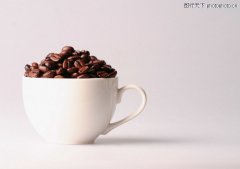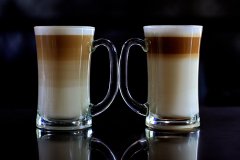Effect of Milk quality of Grandma Niu on foaming Italian coffee bean latte
In general, the fat content in milk is about 4-5% (composed of different types of fat) and exists in milk in the form of fat balls with sizes ranging from 0.1 to 10 microns. With triglyceride (triglyceride) as the core, it is surrounded by a film composed of proteins, phospholipids and glycerides. This natural milk fat globule membrane can effectively prevent milk fat from oxidizing or stale.
Protein in milk
Milk proteins are divided into two types-casein and whey proteins, which appear on the surface of the fat ball film. Casein accounts for 80% of the 3-4% fat in milk, mainly in the form of particles 100-200 nanometers in size, called casein colloids, which contain thousands of casein molecules, calcium phosphate, and water. On the other hand, 20% of whey protein appears mainly in separate form or in small clusters in milk. However, whey proteins tend to accumulate in large amounts when milk is heated; this problem can be avoided by pasteurization, which is widely used commercially (72 ℃, 15 seconds), but it is extremely easy to cause whey protein accumulation when milk is heated with UHT (140 ℃, 5 seconds) and sterilization (115 ℃, 10 minutes). The accumulation of these proteins will bring extra consistency to the milk.
Homogenization process (homogenization)
Homogenization is often used in milk processing to reduce the emulsification of milk fat globules (creaming, the oil layer formed on the surface of milk during storage). Emulsification is caused by the low fat density of milk. By reducing the size of fat spheres, the average process slows down the process of emulsification. In the homogenization process, the milk passes through a small high-pressure valve, and the fat ball is broken and refined. In this way, the number of fat globules on the liquid surface increases, and the protein is absorbed by the fat balls on the surface.
Milk foam: protein enhances the stability of milk foam
Just as homogenization can enhance the stability of the surface layer of milk fat balls, protein plays a key role in the stability of the surface layer of milk, whipped cream, and bubbles in ice cream. By beating or injecting (steam), air forms an unstable interface between air and liquid, which requires the adsorption of surfactant components (made up of proteins). Proteins are adsorbed on the surface of bubbles to increase stability. In general, the protein content in milk is sufficient to meet the need for foam stability (3.5% of milk protein, of which only 5% is enough). In milk protein, casein was found to be preferentially adsorbed on the bubble interface. The stable surface layer formed by milk protein forms a stable milk foam. However, the stability of the foam eventually fades away, the liquid in the foam overflows, and the adjacent bubbles merge with each other to form larger and larger bubbles that eventually collapse.
Milk foam: fat destroys stability
In addition to normal defoaming, there are a series of factors related to milk quality, composition and treatment methods that affect milk foam. In many cases, this is related to milk fat. From a physical point of view, skim milk is ideal for foaming, but it lacks enough flavor and taste, which forces a certain amount of fat to become necessary. However, the increase in fat content has greatly reduced the whipping power and stability of milk foam. The effect of fat on the stability of milk foam was most obvious at 10-40 ℃. In this temperature range, the milk fat ball loses its stability during the foaming process, causing the liquid fat in the fat ball to flow out of the membrane. Heating to 40 ℃, all milk fat will melt, if replaced with vegetable oil, or the use of homogenization process to refine milk fat balls to enhance stability, can help overcome the negative effects of natural milk fat balls on milk foaming.
Effect of Milk quality on foaming
The enzymatic degradation caused by lipase is also an aspect worth considering related to milk fat, which leads to the formation of surface active mono-fatty acid glycerides (surface-active mono-and diglycerides), which is adsorbed on the surface of bubbles instead of milk proteins. Eventually, the bubbles become unstable. Lipolysis can also bring rotten odor, so it is extremely important to prevent lipolysis. This should be the responsibility of the entire dairy supply chain. Starting from the quality control of raw and fresh milk, if the fat globule is destroyed, the lipase activity will be enhanced. Milk lipase is easy to lose its activity under pasteurization. However, lipase can also be produced by bacteria. Unlike bacteria, lipases are heat-resistant in some cases and can be retained even under UHT and sterilization. Therefore, since lipase can only be partially killed during heat treatment, milk contamination should be avoided at all costs.
Effect of Heat treatment on Milk
Although heat treatment has little effect on foaming and foam stability, it also needs to be considered for the sake of product quality, product safety and flavor. Pasteurization, sterilization, and UHT treatment all have their own special flavor characteristics and may be loved or hated by different regions of the world. In areas accustomed to pasteurization or fresh milk, the "cooking flavor" and sulphur flavor in UHT treatment and sterilization (especially the latter) are usually unpopular. On the other hand, in areas that do not drink fresh milk, people will think that pasteurized milk is too insipid and lack flavor, and they will prefer "cooking taste" instead.
The influence of milk selection and production on foaming is an extremely complex process, which requires careful weighing of the pros and cons. On the one hand, milk quality and quality stability, on the other hand, foaming and foaming stability. However, for consumers, texture, flavor and taste accept the key points of the product, which is the most important consideration for any coffee containing milk.

Important Notice :
前街咖啡 FrontStreet Coffee has moved to new addredd:
FrontStreet Coffee Address: 315,Donghua East Road,GuangZhou
Tel:020 38364473
- Prev

Australian white coffee Flat White beat delicate foam temperature mild Italian blend of coffee beans
Australian-style white coffee, unlike cappuccino, 1-beat-3 Espresso,1/3 hot milk, 1-pound-3 milk foam, and sprinkle some chocolate powder or cinnamon powder on the formed micro-convex surface. The Australian white is named F because it is smoother and consistent with the cup noodles, highlights the fineness of the milk foam above, and the temperature is milder.
- Next

How to judge the quality of milk foam? brewed coffee latte flavor coffee
Standard one: milk foam should be delicate, for example: be delicate (what is delicate? No one can explain it in precise words), like velvet (what is velvet? As a national protected animal, how many people dare to hit a swan and touch its velvet? Be slippery (milk is the most slippery, just like this guy is lazy and has nothing left in your mouth.)
Related
- Beginners will see the "Coffee pull flower" guide!
- What is the difference between ice blog purified milk and ordinary milk coffee?
- Why is the Philippines the largest producer of crops in Liberia?
- For coffee extraction, should the fine powder be retained?
- How does extracted espresso fill pressed powder? How much strength does it take to press the powder?
- How to make jasmine cold extract coffee? Is the jasmine + latte good?
- Will this little toy really make the coffee taste better? How does Lily Drip affect coffee extraction?
- Will the action of slapping the filter cup also affect coffee extraction?
- What's the difference between powder-to-water ratio and powder-to-liquid ratio?
- What is the Ethiopian local species? What does it have to do with Heirloom native species?

